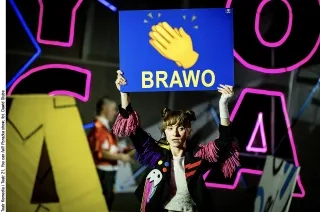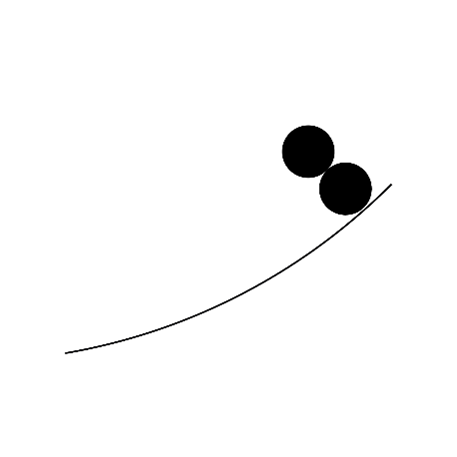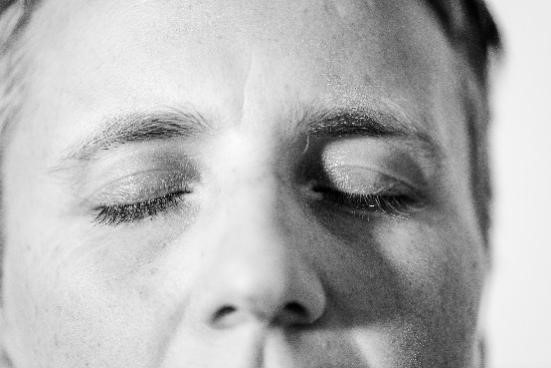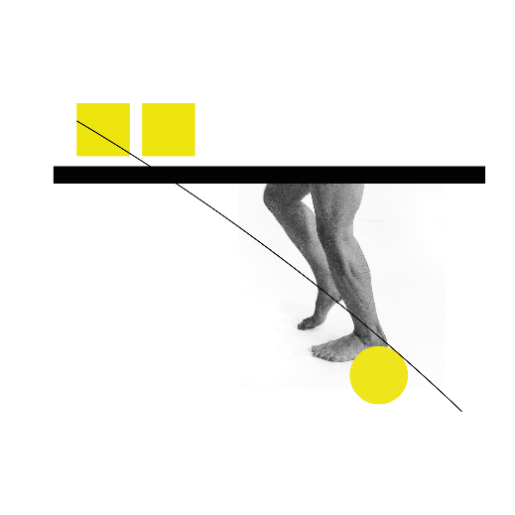Pain and I: A Crip Performance Score
Introduction
I am a queer disabled artist-researcher who works across choreography, dance, live art, performance, disability, crip, queerness, and ecology. I have lived with chronic back and neurological pain for over 20 years (Degenerative Disc Disease). Until recently, I related to my pain largely as a barrier and hindrance to my life and my work as an artist and researcher. Over the past 5 years, I have been exploring what it means to turn towards my pain differently. What if I work with my pain creatively? How can my pain be a collaborator? What if I dance with, rather than against or despite, my pain? What if I embrace the uniqueness of how my chronic pain body moves and what it needs? How can the limitations and possibilities of my chronic pain body be the creative parameters for creating performance?
Part of this research has involved collaborating with disabled dance artist Raquel Meseguer Zafe, who lives with chronic pain and has made work about her own and others’ pain experience. Her seminal work, A Crash Course in Cloudspotting, shares narratives of people living with chronic pain and their experiences of resting in public spaces, exploring rest as a political act1. Meseguer Zafe and I carried out studio-based research together through three week-long residencies over three years between 2018 and 2021, developing dance practices by and for our chronic pain bodies. We explored what kinds of movement aesthetics and methods emerge when we embrace our chronic pain bodies as valid and valuable. We wanted to bring out the tacit knowledge of chronic pain experience through choreographic practice. Drawing on this collaborative research, I disseminated an approach of choreographic tasks that enable the expression, qualities, and skills of chronic pain bodies (Hopfinger 2021, p. 123). I explored these practices further when creating Pain and I (New classical music composition by Alicia Jane Turner; graphics designed by Michaella Pointon; images by Brian Hartley), developing a performance through embracing the spectrum of my chronic pain experience. I wanted to create a performance where the form and content enacted the complexities, as well as the knowledge and insights, of chronic pain.
Pain and I embraces the rich complexities of living with pain and asks: what can pain experience teach us? The piece explores what it means to care for our bodies, ourselves, and each other in times of personal and collective pain. Pain and I has grown into a body of work that includes a live performance, audio piece, graphic score, and immersive installation. Each version presents similar material in distinctive ways and is an artwork in its own right: each version can be experienced as a stand-alone piece or in combination with other versions2. The live performance – which I focus on here – involves experimental dance, bold choreography, intimate autobiographical text framed as a love letter to my pain, and an original new classical music composition by Alicia Jane Turner created in response to the movement and text. I perform the piece naked, emphasising my chronic pain body as a site of knowledge.
This piece of writing is a reflection on, and dissemination of, the live performance. It takes the form of, firstly, a contextualisation of the work and, secondly, a performance score. The score is a creative documentation of the text, choreographies, music, atmospheres, intentions, and sensations of the performance. I bring in aspects of my own experience of performing the work to emphasise the insights that emerge from the doing of the performance. Throughout this writing, there are graphics and images from the Pain and I graphic score3. I include these not so much to illustrate ideas but to give a sense of the felt qualities of the performance. I echo Anna Tsing’s approach of using images not to show ideas directly but ‘to present the spirit of my argument’ (2013, p. viii). The images and graphics are also offered as suggested moments of rest and reflection. You are invited to pause and take a few breaths whenever you encounter a graphic or image.
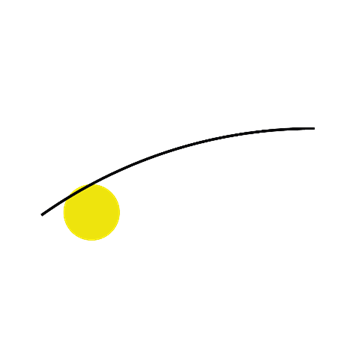

graphic 1: A yellow circle with a black curved line through it. / graphic 2: A black and white image of Sarah Hopfinger’s chest and head, her eyes are closed and her two hands are held softly close to her face.
Crip
The critical and artistic context of Pain and I is the concept and practice of crip. With the creative devising process and the performance, my aim was to crip performance practice through the particularities of my chronic pain. For disabled scholar Alison Kafer, crip refers to a ‘cripped politics of access and engagement’ (2013, p. 3), where ‘[t] o say that something is “political” . . . means that it is implicated in relations of power and that those relations, their assumptions, and their effects are contested and contestable, open to dissent and debate’ (Kafer, 2013, p. 9). Pain and I is a performance of contesting and re-approaching dance and performance practice through working creatively with chronic pain: cripping the methods of performance through embracing the skills of my chronic pain body.
Embracing my chronic pain body as the aesthetic and choreographic parameters for creating and performing, Pain and I can be understood as an affirmative exploration of disability. Crip is an affirmative model that argues that an individual’s impairment is a crucial aspect of their identity and their place within disability or crip culture. Reclaimed from the derisive term ‘cripple’ – a similar process of reclaiming language as with other movements such as queer activist and academic movements – crip is a politicised view that challenges pity and deficit narratives of disability, refusing the configurations of disability as ‘tragedy, limitation, dejection, and loss’ (Belser, 2015, p. 3). With Pain and I, I wanted to move beyond the limited notion that living with chronic pain is innately tragic and to focus on the rich complexities of a life lived with pain.
Kafer also points out the risk of some crip perspectives where there is an over emphasis on affirming disability. She implies that there needs to be room within crip culture for those of us who are both proud of being disabled and may also wish they did not experience their impairments (Kafer, 2013, p. 10). Pain and I is about embracing the complexity of chronic pain lived experience, which involves both a bold embrace of chronic pain life as well as acknowledging the hardships and unwelcome aspects of living with pain. Pain and I is about creating a welcoming space in which I can admit the horror and extreme difficulties of chronic pain, as well as celebrate it as a rich lived experience that can bring insights and particular qualities of being – qualities such as care, pleasure, slowing down, generosity, tenderness, love, even joy. With chronic pain, I have found that there needs to be room for acknowledging the loss and extreme difficulties, as well as embracing the lessons and insights. Pain and I explores the complexity of my relationship to pain and opens up space where pain experience – in its paradoxes and ambiguities – can exist. For me, a crip context can enable me to acknowledge the hardship and unwanted aspects of my chronic pain experience at the same time as celebrating chronic pain life as valid, valuable, richly complex, and as a site of knowledge.
Practice-led Research
By drawing on the performance material directly from Pain and I, I want to bring out the knowledge contained in the performance itself, as opposed to using the performance simply to illustrate theoretical ideas. As choreographer Rosemary Lee puts it, the aim in writing about dance is to value the ‘knowledge generated by the practice itself rather than producing interpretations through analytical frameworks’ (Lee, Pethybridge 2019, p. 471). With practice-led research, I understand performance as a thinking and theorising activity (Vincs,2007, pp. 100-108; Hopfinger, Bissell, 2022, pp. 47-48), treating performance as ‘knowledge or philosophy in action’ (Barrett, 2007, p. 1). I follow many disabled scholars who ‘acknowledge the embodied nature of knowledge production by writing their own bodies into their research’ (Birk, 2015, p. 391). Here, I explore how artistically collaborating with chronic pain has something to say about what it means to crip performance.
Instructions
You are invited to engage with this performance score in ways that are most useful, interesting, and inspiring for you. Take your time. Read slowly. Read quickly. Read alone, or with others. Read out loud. Ask someone else to read to you. Take turns. Focus on one thing that stands out. Let the whole thing wash over you at once. Read in small parts over a day, a week, or longer. Follow momentum when it comes. Be led by your curiosities. Allow distractions and tangents to occur. Hold the material lightly. Confusion is allowed. There is no pressure to understand fully. Being lost can be the most creative place to be. Let what resonates enter your body. Your body and mind are collaborators in the meaning-making of this work.
Respond to the content in any way you wish – pausing, imagining, writing, drawing, pondering, moving, dancing, going for a walk or a wheelchair spin, or just take it in. Reconfigure what studying can be – taking a long bath, talking to a friend, sitting or lying down in silence. Feel free to agree, disagree, question, understand, misunderstand, explore, and query what you find here. Let what follows be a somatic experience that involves your body, mind and heart. Prioritise care. Prioritise love.
Here. Pain is welcomed in. Pain is allowed to take up space. Your pain, your experiences, your body, can take up space. Permission is given. Your moods, emotions, feelings... are welcome. Welcome to this work. Let it be catching.

graphic 3: A yellow circle with a black curved line through it.
Pain and I
You’re entering the performance space. I am unseen but here. Long continuous lines of definite but drifting synth sounds encompass the space – the sounds are wavering-yet-solid, inviting in a slowness of body and thought.
I am offstage, listening to the sounds of the synth and you – the spectators – arriving. I lean into the sounds, noticing how I am feeling. I ask the performance to hold me, wherever I am at.
I have performed this work over 25 times in the last two years. I have experienced many different feelings in these moments offstage before stepping into the performance – depending on my pain levels, what is happening in my life, and other currents and forces around me. Sometimes I am nervous, other times already very grounded. I might be carrying different feelings: unease, excitement, lightness, intensity, openness, defiance, or something else. Whilst my feelings can often seem like a problem in the hours leading up to the performance – I worry that they might get in the way of my focus of doing the show – when I am here, leaning into the work and entering its non-judgmental atmosphere, I know that any feelings are allowed. In fact, they are welcomed. There is no need to make a big deal of them because here I do not need to push feelings away, but I also do not need to shout about them. I am not ‘leaving things at the door’ and trying to be ‘neutral,’ but I am also not having to explain myself.
I invite the performance to acknowledge me today, to bathe me in non-judgement, no strings attached. It is always such a relief, this re-realisation that however I am feeling, this work can hold it, and that I do not have to be something that I am not. It is as if, each time I meet with this performance, I get to become good friends with myself, wherever I am at.
graphic 4: Two black circles with one black curved line though them.
I set an intention. I ask, what do I need? I try to let the intention find me, rather than create it from my head. I wait to see what emerges, not wanting to predict. It might be as simple as ‘to be present with myself and the audience,’ or something more complex like ‘to be gentle and ambitious,’ ‘to perform with a quiet boldness,’ or ‘to be energetically slow.’
graphic 5: A black and white close up image of Sarah Hopfinger’s face with her eyes closed.
The sound continues – a lengthened generosity of a beginning.
The audience begins to settle. I walk into the darkness of the stage, confident in being here and at the same time thankful that I am not yet visible. I am glad of this slow beginning.
The sound fades, creating a silence that greets my voice. I speak, amplified: my voice surrounding you with a soft frank friendliness. It is dark: we are all here, I am speaking, but this performance has its eyes closed for now.
Dear audience member,
Hello. My name’s Sarah, I’m 35 years old, and I am in companionship with pain.
I remember that these are everyday facts about me. I want the bigness of the pain to be here, but I don’t want to dramatise it – I want the frankness of the pain’s reality to settle in, to simply be, to get to exist on its own terms.
You might have come to this performance with others, or on your own – however you have arrived here, however you are feeling, it is perfect, welcome.
Take however long you need to settle in to where you are. Throughout this experience feel free to do what is most comfortable for you – you can sit, stand, lie down, stretch, lean, move around. You can stim, snack, drink, make noise, look away, close your eyes. If the content of this performance becomes too much, or for any other reason, you can leave and come back.
Though I face away from you, I sense you and direct my voice towards your presence.
You do not need to be a polite audience member. You’re invited to do what is most caring for your body and mind. This space does not merely accept you but needs you to be you for it to be itself. This space shakes its head at pressure and judgment. It wants another way.
Long, tender layers of sound emerge from the darkness, gently touched by piano keys and stroked by string music. My voice carries on, content to rest into the sounds.
We are in an arrival: inside a gesture of being here that speaks towards an atmosphere of bodies being what they already are.
This is a space to rest into your body, to acknowledge yourself however you are, and to settle in to the richness of listening to pain.
The darkness lifts ever so slightly, letting the presence of the back of my naked body emerge; a glimmering right to be here.
Four strokes from the violin strings ready my voice to carry on. I direct myself towards the pain. I smile to myself, so that I can enter the following text with warmth. But I don’t want to over-curate this warmth – this is not about putting a positive spin on what is difficult. It is about finding a relationship – each time – to the pain. The smile is perhaps more about smiling at my relationship and journey with the pain – rather than the pain itself. A kind of warmth towards this ongoing process.
I am listening to you... to try to get to know your qualities, characters, and atmospheres... to mark you, honour you, see what you have to say, and let you take centre stage. I hope that I am giving you your due.
The music is building towards something. I feel a lightness emerge inside of me – it is as if a softening gets to come up in my body. Perhaps these sensations come from this act of openly naming my commitment to honouring the pain, to giving it its due.
I give things space – enjoying the lightness and softness – before I speak again.
One – The Turn Towards
My body is becoming more illuminated by warm fading up lighting. You can see that I have brown, blonde and grey hair that is short on the top and long at the back. I am standing facing away, speaking into a microphone. There are small movements of my head determined by my speaking. You can now see the full length of my body, its skin and shape. I am seeing you with the back of my body.
The air calls you in. The air calls you in. The dust settles you here. The breaths stroke your presence. Welcome.
The sound is building to a rhythmic pattern of light string picking energy that is held by longer strings of reflective wide openness. The music speaks of a playful airy welcome accompanied by vibrational deeper tones of a slowed down invocation. The music is a holder for me; its emotion allows me to be matter of fact about what I am saying. I remind myself that I do not need to push for feeling. I can let the sound, words and presence of my body, do the work.
Welcome to the wakeful nights, the unease of daybreak, the hindered steps, the troubled ones. Welcome to the stiffening and shrinking of my world, the stretching of my fear and despair, the lengthening of my discontent. Shake me up and shatter me. Leave me lying crying in the fields. Let me flounder. Flame up and compress my smiles and words. Undo my sense of self. Shoot me from the inside and ache it into my identity. The air calls you in, speaking in a slowed disenchanted voice: there is space for you here, space for the unhealed.
I let this sentence about the unhealed settle in to the space. I let the space settle in to this sentence.
The touches of breezes and whirlwinds that have brought you here – the currents of quiet and chaos – sound out their bells; booming your validity, vastness, and vulnerability. Welcome the unchosen ones, the ones left out, the disruptive, uncomfortable, quietened, shameful ones. The air calls you in. The air calls you in.
A high shimmering layer of sound enters in and sits on top of the rest of the music, with pride. The sounds are being kind to my voice.
Your shimmering of the unbearable – your shadow sides – crisscross the now, and we scream: come back to me, there’s space for you here. Your kiss of brokenness, your kiss of damage, it wets, softens, and calms.
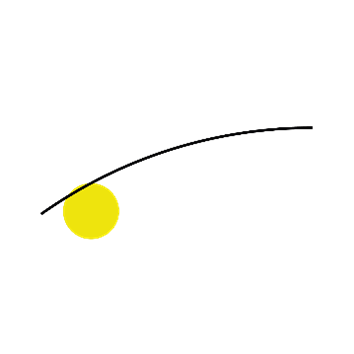
graphic 6: A yellow circle with a black curved line through it.
The long kind tones of the synth have returned, growing out of the previous music. I take a step away from the microphone and – ever so small and slow – I turn. I turn one way, then the other. My feet stay planted on the ground. My turning back and forth grows bigger, but still slow. I am led by my arms and the intention of moving to care for my body. This is a turning towards: towards you, towards the pain, towards care. My eyes are still closed, letting myself be gradually seen by you. A welcoming of the space and letting myself be welcomed. I enjoy being unrushed.
Now I am turning with my eyes open, seeing you directly for the first time. Taking my time to see you and to let you see me.
I turn to face you, my hands resting on my heart and stomach, rising and falling with my breath. I stretch out and open my arms. I do it again and again and again.
The sound leaves as my voice emerges, at first a whisper and then building into a loud call.
I dance with you. I dance with you. I dance with you.
I am setting an intention for the performance, for my life.
I dance with you. I dance with you. I dance with you.
I look into the space – finding the ‘you’ in different places and directions of the space – the ceiling, that corner, straight ahead, the floor... sometimes meeting an audience member’s gaze.
I dance with you. I dance with you. I dance with you.
I let the repetitions wash over me. I let it become a mantra.
graphic 7: Two black circles with one black curved line though them.
I step forward into the vibrations of the repetitions, into the next section.
Two – The Unwinding Declares
You can see me clearly. I am 5 foot 3 inches. I have a long back and short limbs. I am ready to be fully looked at.
I remind myself that what follows is a stark declaration of hardship – a necessary acknowledgement. There is also a return to the smile and a connection to tenderness and love, subtle but there.
I am scared of this body. I’m scared of this body. I am scared of this body. I am scared of its unpleasant ways, of its dizzying, threatening, and unpredictable ways... of its weaker-than-it-was ways... of its loss of life-ways.
I let my body be present. I give a note to myself to not do too much with my voice, to not try and do all the work, to let things speak for themselves.
I am scared of its discs-and-muscles-deteriorating-and-thinning-causing-pressure-unseen-on-nerves-pressing-prodding-shooting-winding-around-everywhere. I am scared of the weightiness-expanding, of the pushing-tightening-flaming-heat-thickening-the-emotional-physical-mood-tiring small and hugeness. I am scared of what has been worn away and is unrecoverable. I am scared of this damage. I am scared of this damage.
Acceptance sometimes creeps up from inside the words. I let the acceptance ring through my voice.
I am scared that this body forgets about its possibilities, enthusiasms, and alive-ness. I am scared of being attached to an ideal of this body and wishing that it would return to its former glory. I am scared that I am to blame, that I could have done more to help before it got so bad, and that I have pushed this body too far. I’m scared of living with too much regret.
I can pause, when it feels right, and often there is a relief that makes itself known in the pauses.
I am scared that this body isn’t getting what it needs and that I am not up to the task. I am scared that this body will keep getting overwhelmed and that more damage will be done. I am scared of this body. I am scared of this body.
I let the extremities of what has been said hang in the air.
graphic 8: A black and white close up image of Sarah Hopfinger’s face with her eyes wide open looking up and out.
I step forwards into the third part.
Three – The Holding Up
The space lights, ready to be explored.
You are somewhere here.
My hands move about my lower back, emanating to my head, legs, and the air around me – gesturing to the pain, with commitment and futility. The gesturing becomes a movement of placing the pain in specific areas of the space – up there, near the audience, on the floor, behind me, all around. Playfulness arrives. Pathos sometimes enters.
You are like this.
I ruffle my hair, messing it up. I have a drink from a glass of water. I spray a mouthful of water into the space, letting the droplets fall on top of me. I busy by hands in front of my face, creating a fuzzy blurriness between you and me. I do this for a while, a continued barrier between us. Then – just like that – I let it go.
You’re from here to here.
You’re from here
to here.
You’re from here
I walk back and forth, turn to you and say ‘hi.’ I mean it. A quotidian communication. I travel as far as I can to the edge of the space, finding the measurement. I am happily grappling with the impossibility of defining my pain.
to here.
You are from here
I walk in haphazard directions, jumping, turning, stopping, retracing my steps, winding around. I find an exact place and mark it with my foot.
to here.
You’re from here
Beats of sound kick in, taking me into a club scene of energetics that say: let go. I am dancing. Moving more than I have so far. Green, pink and purple lights flash me into a fuck it celebratory dance. I am leaping, running, stamping, throwing myself about. I spin round and round.
I am taking up a lot of space.
graphic 9: A black oblong line horizontal, with a thinner black curved line across it, and two yellow squares sitting on the horizontal line and a yellow circle below, with a small image of Sarah’s legs dancing.
The sound and light keep going, keeping me going. I become dizzy from the spinning. I let the dizziness overtake me. It’s everywhere. I break out of the spinning and fling my body here and there. I let myself access celebration.
My dancing brings me close to you at one point, and I nearly topple towards you. But I keep going, traveling across the space, letting myself be danced.
This goes on for nearly five minutes. I am at the top of my energy.
Sound and lights reach a defiant stop. I stop too. I drink some water, taking my time. I am breathless and enlivened.
graphic 10: A black line going downwards striking through a yellow and a black circle.
I place myself in the centre, standing, seen, ready to go down further.
Four – The Downward Triumph
The sound begins with single, cold notes – a saturated synthesizer, like frozen beams of light. Soon, notes join in from different directions and angles, surrounding my voice. I invite in the materiality of repetition, asking the words to take me somewhere, playing with the spectrum of meanings to be discovered here.
I cannot forgive you.
I cannot forget you.
I cannot trust you.
I cannot see you.
I cannot leave.
I cannot be rid of you.
I cannot be sure.
I cannot be bothered.
I cannot remember what pleasure feels like.
I cannot hug and kiss you.
I cannot make love with you.
I cannot live like this.
I cannot connect.
I cannot be healed.
I continue speaking these lines in different combinations. The music becomes undulating electronic waves, joined by spiralling high pitched clusters and dry fluttering. It twinkles and swirls. A deep, heavy bass flows underneath, urging through. A slow, throbbing beat is joined by a high-pitched clap as my voice slowly fades out and the music almost drowns me.
I cannot be sure I cannot forgive you.
I cannot make love with you, I cannot see you.
I cannot remember what pleasure feels like, I cannot make love with you.
I cannot trust you, I cannot be bothered.
I cannot be sure I cannot trust you.
I cannot be sure I cannot live like this.
I cannot live like this.
It is euphoric, climactic, all encompassing. I enjoy being overtaken. I let the emotion come if it does. I allow the words to be mantra, anger, celebration, declaration, sadness, acceptance, frustration, boredom, difficulty, joy. I get to go fully in to the feelings here, playfully and seriously. It is cathartic and I am up for it.
I cannot connect, I cannot trust you. I cannot live like this, I cannot be bothered. I cannot be sure I cannot be bothered. I cannot be healed. I cannot forgive you, I cannot be healed. I cannot be healed, I cannot be bothered. I cannot be sure I cannot be healed. I cannot be healed. I cannot be healed. I cannot be healed.
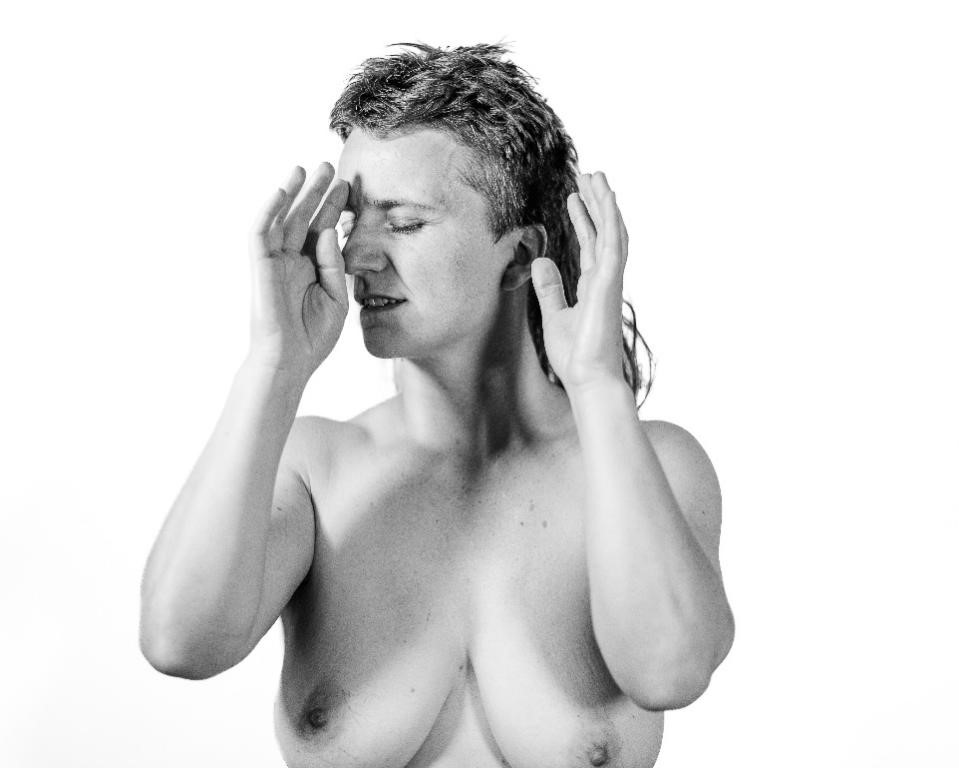
graphic 11: A black and white image of Sarah Hopfinger’s naked torso and head, her head turned slightly towards her hands, which are held lightly in front of her face.
Now the words are left behind, my body leads.
I am facing you, gradually curving my back and straightening, repeating these small movements as they grow into my arms crossing my front, which merges into swinging arms that cause hands to brush my face. This brushing, through its repeating, turns into face and lip touching. I am stroking my face with my fingertips. I am pushing my hands up and down my face, which ripples into another arm swinging that is a kind of beckoning motion seeming to invite the outside of me into the inside.
These are states of moving rather than singular movements.
graphic 12: A yellow circle with a black curved line through it.
The sound is back into the line of synth encompassing the space, with an arrival of tender guitar and faint singing, like a memory. The guitar reminds me of tenderness.
Now, there is a faster stroking of my ears turning into hands back and forth, which arrives into dancing my hands and arms around my head. I am looking at you again through the business of my moving hands. A haze between us.
I raise my arms – ever so slow. There is more stillness and slowness than I expect. I bring my hands to my face, almost a gesture of despair yet there is no dwelling on one image, and soon I feel the pleasure of smudging my hands across my face. Hands push across my face, kneading into skin and down the front of my body, marking skin red – evidence of my physical presence. My body becomes more patient with itself. My body is in discovery, not completion. There is deep pleasure to be found here. My arms are now leading the energy up, across, around, inside the folds of space around me – a movement that touches the textures of air flows. The opposite to effort and forcefulness.
I have my head deep in my elbow. I am pushing my head through my angled arm, emerging to see you from deep inside.
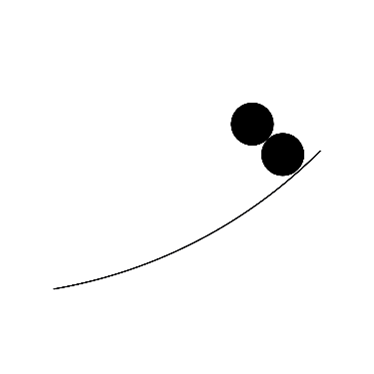
graphic 13: Two black circles with one black curved line though them.
Five – The Going On Returning
I sit down, I am close to you – a body breathing nearby.
Things have been so hard between us. There was a time when I wasn’t sure if we would survive. We would lie together, sit, walk, and eat together – constantly be together. I’d try to find ways to be a tiny bit comfortable with you. I did all of the things that had helped in the past, like taking things easy, giving you space and time, responding to you rather than simply being angry. But nothing helped. We were so stuck. I couldn’t see a way out.
I am glad to tell you this, without asking for sympathy.
I talked about you to my friends and family – they were worried and wanted things to be better. But soon this felt like pressure, so I stopped talking about you. It felt easier to be quiet.
Single, sporadic repeated notes appear from the silence, that echo into the distance. They are then accompanied by deeper underpinnings and light flutterings. It whispers and ripples. I enter into reflection, remembering the hardest of times. I feel able to share this with you because of everything that I we have been through in the last 40 minutes.
We kept having to leave in the middle of things – the middle of dinner, visiting people, work, performances, conversations, phone calls. I cancelled so many plans that I started to not make them. I was tired of explaining about us. It felt easier not to do things, to retract further and further into myself, and to be in this difficulty just with you.
This speaking reveals itself to me as a love letter to my pain. I let it happen, unafraid of expressing the extremes of my experiences.
I was embarrassed by you. I didn’t want others to see how bad things had got between us. My embarrassment turned into a deep shame. Inside of this shame, I became unsure of who I am. I wished you would disappear for good. I wanted my life back, a life without you.
I lie on my back, resting into the floor, letting it hold me, in my sweat and feeling.
This lying down reminds me of the uncountable hours I have had to lie down deep in pain flare ups. I am melting into the acknowledgement of how immensely the pain has been, and continues to be, so part of my life.
It can get so boring. I get so bored: I get bored of you, of us, and our problems, of how small my world can get, and of how entwined we are.
I look softly and directly towards you, letting you in on a secret. There is a friendliness in my admission of fear.
Sometimes, I still live in fear that you’ll keep trying to spoil my life, to trouble me, unwind me, make me disappear, and be my crisis.

graphic 14: A black line going downwards striking through a yellow and a black circle.
I’ve spent a lot of time hating you and I’ve used so much energy up to carry on hating you. I’ve hidden you, ignored you, played you down, tested you, and planned many times that you will leave me.
I move to the middle of the space, standing up, ready to expand towards the spectrum of things and the insights that lift me into another way of life.
But you’ve hung around. You’ve stayed with me for more than 20 years. You’ve seen me make friends, grow into an adult, and leave home. You’ve seen me fall in love and fall out of love. You’ve seen me study, work hard, be sure of myself, overdo it and lose my confidence. You’ve seen me grieve and become an aunty. You’ve seen me realise and welcome in my queerness. You’ve seen me grieve again, leave things behind, and start to grow grey hair.
I allow myself to honour persistence.
Even when you’re not loud, not making yourself so known, I think about you every day. You’re never not here. You’re so committed to me. You are my intimate companion. My unwanted lover. I dance with you. You are too real and you are not always believed. You have a pattern that you don’t stick to and I dance with you.
I breathe it all in.
The air calls you in and you ask for gentleness and another kind of time. You tell me about soft energies, peaceful ambitions, and a quiet boldness. If I am there to listen, you whisper revelations. You have the power to push me away from others and you have the power to create beautiful intimacies. I dance with you.
The sound is growing. I enjoy speaking these words, there is momentum and boldness.
You know about panic, overwhelm, and rage. You know about fragility, kindness, and care. You know about those lines from that song that goes: ‘ring the bells that still can ring, ring the bells that still can ring, forget your perfect offering, there is a crack a crack in everything, there is a crack a crack in everything, that’s how the light gets in, that’s how the light gets in, that is how the light gets in.’
I am calling out with love.
You know about deep disappointment and the shattering of expectations. You know about being rebellious, and what it means to dare to live another kind of life. You know about despair and renewal.
I don’t know what our future holds and I don’t know how you’ll be, but I know that you’re more than what you seem and that so much is tangled up in you.

graphic 15: A black and white image of Sarah Hopfinger, with her head pushed into her elbow, and the other arm stretched outwards.
The music fades. My hands find my heart and stomach, belonging me to the here and now. I am on my way towards a slow goodbye, an echo of the slow beginning.
The air calls you in. The air calls you in. The dust settles you here. The breaths stroke your presence. Welcome. There is space for you here, space for the unhealed.
I return to seeing you with the back of my body. The performance is closing its eyes, gradually. I turn following my arms, letting care and pleasure again lead my movements. A gathering in. Keeping some for myself.
The synth space encompassing sounds are back. My voice meets the sound and you.
Dear audience members,
Thank you for being who and how you are. You may need to take your time to move from this experience into the rest of your evening. The touches of breezes and whirlwinds that have brought you here – the currents of chaos and quiet – sound out their bells, booming your validity, vastness, and vulnerability. This space does not merely accept you but needs you to be you for it to be itself. This space shakes its head at pressure and judgement. It wants another way. Thank you.
We all fade out slowly. Light. Sound. Body. Performer. Audience. A lengthened goodbye so that things might continue beyond here.
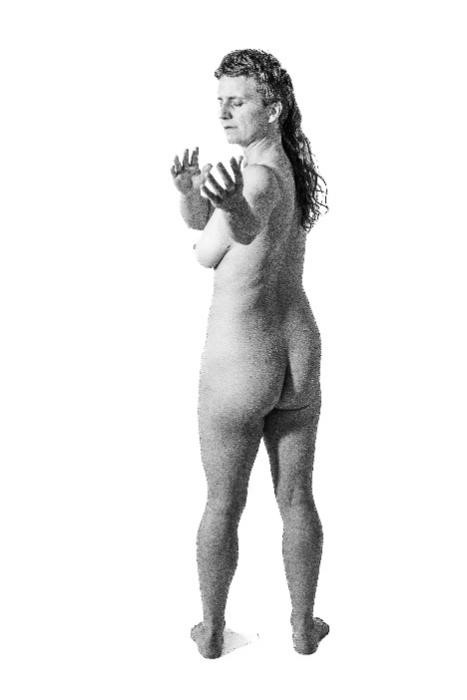
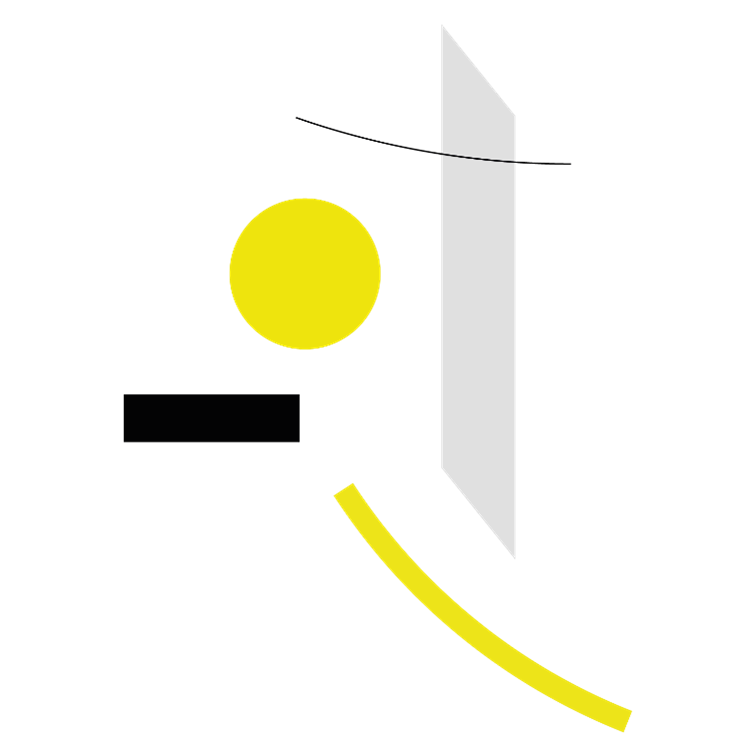
graphic 16: A black and white image of Sarah Hopfinger naked, full length facing away, she is turning with her arms softly stretched out. / graphic 17: Yellow, black and grey circles and line shapes, criss-crossing each other.
Wzór cytowania / How to cite:
Hopfinger, Sarah, Pain and I: A Crip Performance Score, „Didaskalia. Gazeta Teatralna” 2024, nr 181/182, https://didaskalia.pl/en/article/pain-and-i-crip-performance-score.

